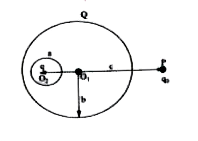Two concentric, thin metallic spheres of radii R1andR2(R1>R2) charges Q1andQ2 respectively Then the potential at radius r between R1andR2 will be (k=1/4π∈)Solution in Telugu
k(Q1+Q2r)
K(Q1r+Q2R2)
k(Q2r+Q1R1)
k(Q1R1+Q2R2)
The correct Answer is:C
Step by step video, text & image solution for Two concentric, thin metallic spheres of radii R_(1) and R_(2) (R_(1) gt R_(2)) charges Q_(1) and Q_(2) respectively Then the potential at radius r between R_(1) and R_(2) will be (k = 1//4pi in) by Physics experts to help you in doubts & scoring excellent marks in Class 12 exams.
Updated on:21/07/2023Topper's Solved these Questions
- ELECTROSTATICSBOOK - AAKASH SERIESCHAPTER - ELECTROSTATICSEXERCISE - PRACTICE SHEET (EXERCISE -IV ELECTRIC POTENTIAL & POTENTIAL ENERGY) (LEVEL - II (ADVANCED) MORE THAN ONE CORRECT ANSWER TYPE QUESTION)
1 Video
- ELECTROSTATICSBOOK - AAKASH SERIESCHAPTER - ELECTROSTATICSEXERCISE - PRACTICE SHEET (EXERCISE -IV ELECTRIC POTENTIAL & POTENTIAL ENERGY) (LEVEL - II (ADVANCED) LINKED COMPREHENSION TYPE QUESTION)
2 Videos
- ELECTROSTATICSBOOK - AAKASH SERIESCHAPTER - ELECTROSTATICSEXERCISE - PRACTICE SHEET (EXERCISE -IV ELECTRIC POTENTIAL & POTENTIAL ENERGY) (LEVEL - I (MAIN) STRAIGHT OBJECTIVE TYPE QUESTION)
19 Videos
- ELECTROMAGNETICSBOOK - AAKASH SERIESCHAPTER - ELECTROMAGNETICSEXERCISE - ADDITIONAL EXERCISE
6 Videos
- ELEMENTS OF VECTORSBOOK - AAKASH SERIESCHAPTER - ELEMENTS OF VECTORSEXERCISE - QUESTIONS FOR DESCRIPTIVE ANSWERS
9 Videos
Similar Questions
A conducting sphere of radius b has spherical cavity with its centre displaced by "a" from centre of sphere, A point charge q is placed at the centre of cavity. .Q. charge is given to conducting sphere and charge qo is placed at a distance c from centre (O1) of sphere such that O1andO2andp are collinear

View SolutionIf a charge is moving towards the centre of an earthed conducting sphere of radius b with uniform velocity v. Distance of two points A and B from centre of sphere are 3a & 2a. Conducting sphere is earthed with an ammeter and resistance in series (as shown)

Net charge on surface of conductor at this instant
View SolutionLet V be electric potential and E the mangitude of the electric field. At a given position, which of the statement is true ?
View SolutionWhat is the radius of the path of an electron (mass 9 × 10-31 kg and charge 1.6×x10–19 C) moving at a speed of 3×x107 m/s in a magnetic field of 6x×10−4 T perpendicular to it? What is its frequency? Calculate its energy in keV. (1eV=1.6×10−19J)
View SolutionFind the components of vector ¯¯¯A=2ˆi+3ˆj along the directions of ˆi+ˆjandˆi−ˆj
View SolutionThe radii of two metallic spheres P and Q are r1 and r2, respectively. They are given the same charge. If r1>r2 then on connecting them with a thin wire, the charge will flow
View SolutionThe insulated spheres of radii R_(1) and R_(2) having charges Q_(1) and Q_(2) respectively are connected to each other. There is
View SolutionThe concentric, thin metallic spheres of radii r_(1) and r_(2) (r_(1) gt r_(2)) carry charges q_(1) and q_(2) respectively. Then the electric potential at distance r (r_(2) lt r lt r_(1)) will be (1)/(4pi epsilon_(0)) times
View SolutionTwo conducting spheres of radii r1 and r2 having charges Q1 and Q2 respectively are connected to each other. There is
View SolutionTwo concentric, thin metallic spheres of radii R1 and R2 (R1>R2) bear charges Q1 and Q2 respectively. Then the potential at distance r between R1 and R_(2) will be
View SolutionThe capacitance of two concentric spherical shells of radii R_(1) and R_(2) (R_(2) gt R_(1)) is
View SolutionTwo concentric spherical shells of radius R1 and R2(R2>R1) are having uniformly distributed charges Q1 and Q2 respectively. Find out total energy of the system.

View SolutionTwo concentric thin metallic spherical shells of radii R_(1) and R_(2) (where R_(1) lt R_(2) ) are charged with q_(1) and q_(2) coulombs, respectively. Using Gauss' theorem show that, (i) the electric field intensity for radius r lt R_(1) is zero, (ii) the electic field intensity for radius r, where R_(1) lt r lt R_(2), is (1)/(4pi epsilon_(0)).(q_(1))/(r^(2)) and (iii) the electri field intensity for radius r gt R_(2) is (1)/(4pi epsilon_(0)).(q_(1)+q_(2))/(r^(2)) .
View Solutionr1 व r2 त्रिज्याओं के दो गोले पर क्रमश q1 तथा q2 आवेश है, उन्हें लघुपथित करने पर तन्त्र की ऊर्जा में परिवर्तन नहीं होगा| यदि q1r2 ............... है?
View SolutionR1 और R2 व्यासार्धो वाले दो गोलों को क्रमशः Q1 और Q2 आवेश दिए जाते है। तब उन्हें इकट्ठे जोड़ा जाए , तो उनके बीच आवेश तब तक बहेगा तब तक Q1R2=Q2R1 न हो जाए।
View SolutionR1 एवं R2 त्रिज्या के दो गोले, जिन पर आवेश क्रमशः Q1 और Q2 है, परस्पर संबंधित किये गये हैं, तब निकाय की ऊर्जा में
View Solution